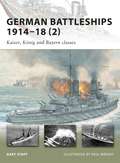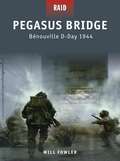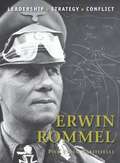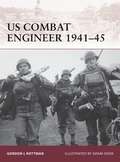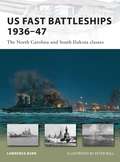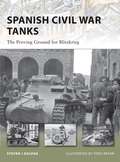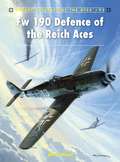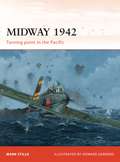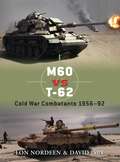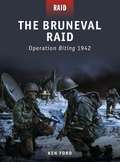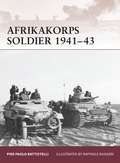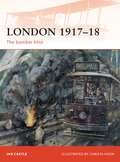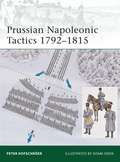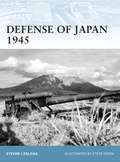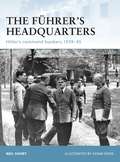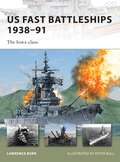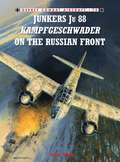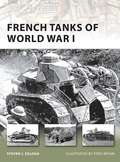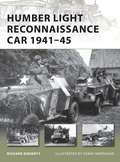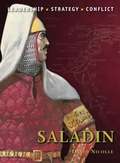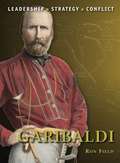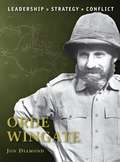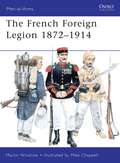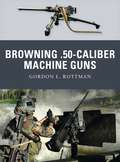- Table View
- List View
German Battleships 1914–18: Kaiser, König and Bayern classes (New Vanguard)
by Paul Wright Gary StaffSupported by official documents, personal accounts, official drawings and specially commissioned artwork, this volume is an informative history of the key classes Kaiser, König and Bayern that formed the backbone of the German Imperial Navy throughout World War I, detailing the technological revolution that had taken place to enable the building of these large dreadnought classes.
Pegasus Bridge: Bénouville D-Day 1944 (Raid)
by Tim Brown Johnny Shumate Will Fowler Alan GillilandThe night before D-Day, light infantry and a detachment of Royal Engineers landed by gliders at Pegasus Bridge, which spanned the Caen Canal. Quickly overwhelming the guards, they managed to hold the bridge and help prevent German reinforcements from reaching the British landing beaches. Will Fowler provides a detailed blow-by-blow account of this classic wartime raid.
Erwin Rommel: Leadership, Strategy, Conflict (Command)
by Peter Dennis Pier Paolo BattistelliNicknamed 'The Desert Fox' for his cunning command of the Afrika Korps, Erwin Rommel remains one of the most popular and studied of Germany's World War II commanders. He got his first taste of combat in World War I, where his daring command earned him the Blue Max, Germany's highest decoration for bravery. He followed this up with numerous successes early in World War II in both Europe and Africa, before facing his biggest challenge – organizing the defence of France. Implicated in the plot to kill Hitler, Rommel chose suicide over a public trial. This book looks at the life of this daring soldier, focusing on his style of command and the tactical decisions that earned him his fearsome reputation.
US Combat Engineer 1941–45 (Warrior)
by Adam Hook Gordon L. RottmanAt its peak in World War II, the United States Army contained over 700 engineer battalions, along with numerous independent brigades and regiments. The specialized soldiers of the Engineers were tasked with a wide variety of crucially important tasks including river bridging, camouflage, airfield construction, and water and petroleum supply. However, despite their important support roles, the engineers were often employed on the front lines fighting beside the general infantry in the desperate battles of the European theatre. This book covers the role of these soldiers, from their recruitment and training, through their various support missions and combat experiences, forming an account of what it was truly like to be a combat engineer in World War II.
US Fast Battleships 1936–47: The North Carolina and South Dakota classes (New Vanguard)
by Peter Bull Lawrence BurrThis volume details the design, construction, and operation of the first six of the ten US fast battleships, two of the North Carolina class and four of the South Dakota class. These six battleships were all authorized in 1936 and were the first vessels built in the US since 1923. Consequently, these ships benefitted from enormous technological leaps, with improvements in ship design, power, armor, armament and the single most important improvement the use of radar guided fire control helping to change the course of the war in the Pacific. Packed with first-hand accounts, battle reports, and specially created artwork this book tells the story of these war-winning vessels.
Spanish Civil War Tanks: The Proving Ground for Blitzkrieg (New Vanguard)
by Steven J. Zaloga Tony BryanThe tanks used during the Spanish Civil War are not often examined in any great detail, and are often labeled as little more than test vehicles in a convenient proving ground before World War II. But, with groundbreaking research, armor expert Steven J Zaloga has taken a fresh look at the tanks deployed in Spain, examining how future tanks and armored tactics were shaped and honed by the crews' experiences, and how Germany was able to benefit from these lessons while their Soviet opponents were not. Based on recently uncovered records of Soviet tankers in Spain and rare archival accounts, this book describes the various tanks deployed in Spain, including the PzKpfw I and the T-26.
Fw 190 Defence of the Reich Aces (Aircraft of the Aces)
by John WealRenowned aviation author and artist, John Weal, presents the last volume of Fw 190 Aces not previously covered in the Aircraft of the Aces series. From mid-1942 until the end of the war, German fighter pilots were deployed in the defence of the homeland in an effort to halt the near-constant bombing raids by Britain and America. This book tells their story, from the moment when the Luftwaffe began to retreat to the dying days of the Reich. Using previously unpublished photographs, this book charts the story of the men who earned their status as aces while fighting a hopeless battle to protect the land and the people they loved.
Midway 1942: Turning point in the Pacific (Campaign #226)
by Howard Gerrard Mark StilleIn less than one day, the might of the Imperial Japanese Navy was destroyed and four of her great aircraft carriers sank burning into the dark depths of the Pacific. Utilizing the latest research and detailed combat maps, this book tells the dramatic story of the Japanese assault on Midway Island and the American ambush that changed the face of the Pacific war. With sections on commanders, opposing forces, and a blow-by-blow account of the action, this volume gives a complete understanding of the strategy, the tactics, and the human drama that made up the Midway campaign, and its place as the turning point in the Pacific war.
M60 vs T-62: Cold War Combatants 1956–92 (Duel #30)
by Richard Chasemore David Isby Lon NordeenDesigned for the battlefields of Europe at the height of the Cold War, the M60 and T-62 were the premier combat tanks of their day. However, it was in the deserts of the Middle East that they finally met in battle. This new Duel title examines the design and development of these main battle tanks, identifying their strengths and weaknesses, and describing and analyzing their performance on the battlefield during the Yom Kippur War, the Iran–Iraq War, and the first Gulf War.
The Bruneval Raid: Operation Biting 1942 (Raid)
by Howard Gerrard Ken Ford Alan GillilandIn the darkest days of World War II, the British planned a daring airborne operation to capture the secret of the new German radar. Lead by Major John Frost, a company of paratroopers dropped into Bruneval on the French coast, and quickly neutralized a small German garrison. Then began a desperate fight for time as the British tried to dismantle the German radar and evacuate back to England, as ever more German units converged on their position. Using artwork, photographs, and detailed maps, this action-packed narrative puts the reader in the planning room and on the battlefield of one of the greatest raids of World War II.
Afrikakorps Soldier 1941–43 (Warrior)
by Pier Paolo Battistelli Raffaele RuggeriThis book explores the experiences of the German Afrikakorps soldier during the North Africa campaign, from the Korps' arrival in–theatre in February 1941 to its eventual surrender in Tunisia in May 1943, with a particular focus on the intense period of warfare in the Western Desert between 1941 and 1942. Under the leadership of one of the war's most famous commanders, Erwin Rommel, the Afrikakorps grew to include a broad range of armour, infantry, artillery, anti-tank, engineer, communications, supply, medical and service elements. The soldiers of the Afrikakorps considered themselves as part of an elite, a highly select group that had no equal, not only in the German Army, but in the rest of the world.
London 1917–18: The bomber blitz (Campaign #227)
by Christa Hook Ian CastleOn a sunny May afternoon in 1917, the peace of an English seaside town was shattered when a flight of German Gotha bombers appeared without warning. Twenty-three Gothas had set out to attack London in this first bomber raid, but heavy cloud forced them to target Folkestone and the Shorncliffe army camp instead. It was the start of a new phase of the war aimed at destroying the morale of the British people. London's defences were quickly overhauled to face this new threat, providing the basis for Britain's defence during World War II. This book tells the story of the Gotha and the massive Staaken 'Giant' bomber raids against London.
Prussian Napoleonic Tactics 1792–1815 (Elite)
by Adam Hook Peter HofschröerWritten by an expert on the Prussian army of the Napoleonic era, this is a fascinating insight into the 18th-century evolution of the Prussian forces into the war-winning troops of the final battles against Napoleon. Using contemporary materials including drill regulations, instructions, staff and regimental histories and after-action reports, this book provides a compelling history of Prussian tactics from 1792 until 1815. It includes studies of the professional Prussian army during the Revolutionary Wars and the mass mobilization of a conscript army that fought during the Wars of Liberation and Waterloo. Following on from the success of Osprey's other Elite Tactics volumes, this is a must-have for serious students of Napoleonic warfare, armchair generals, and wargamers alike.
Defense of Japan 1945 (Fortress #99)
by Steven J. Zaloga Steve NoonIn 1945, with her fleet destroyed and her armies beaten, the only thing that stood between Japan and an Allied invasion was the numerous coastal defence positions that surrounded the islands. This is the first book to take a detailed look at the Japanese home island fortifications that were constructed during 1941–45. Utilizing diagrams, specially commissioned artwork, and sources previously unavailable in English, Steven Zaloga examines these defences in the context of a possible Allied invasion, constructing various arguments for one of the greatest 'what if' scenarios of World War II, and helping to explain why the Americans decided to go ahead with a nuclear option.
The Führer’s Headquarters: Hitler’s command bunkers 1939–45 (Fortress)
by Adam Hook Neil ShortThe 100th title in the Fortress series, this book describes and examines the Führerhauptquartiere – the 14 or so headquarters built for Hitler. Revealing their locations and how they were used to direct the Nazi war apparatus, this is a fascinating insight into a range of historical sites from Berghof to the Wolf's Lair. With a map showing the locations of all of Hitler's bunkers and fortifications on the eastern and western fronts and illustrated with photographs and specially commissioned artwork, this book is an essential introduction to Hitler's command structures and recreates numerous bunkers and buildings which were destroyed by Allied bombing raids or by fleeing German troops.
US Fast Battleships 1938–91: The Iowa class (New Vanguard)
by Peter Bull Lawrence BurrIn 1938, the United States abandoned the constraints imposed by the Washington Teaty and began work on a new class of super-battleships. This book covers the design, construction, and employment of the four Iowa-class battleships, the largest in the American fleet. During World War II, they served as guards for the aircraft carriers and their bombardments provided cover for the numerous landings in the Pacific. At the war's end, the Japanese signed their surrender on the decks of an Iowa-class battleship, the USS Missouri. After World War II, the ships continued to serve, providing support during Korea, Vietnam, and even the first Gulf War. This book tells the full story of the greatest of the American battleships.
Junkers Ju 88 Kampfgeschwader on the Russian Front (Combat Aircraft)
by John WealThe Ju 88, "Wunderbomber†? was the main punch of the Luftwaffe's bomber arm during the initial invasion of the Soviet Union and went on to provide critical ground support to the advancing Wehrmacht. This book tells the complete story of the Ju 88's activities on the Eastern Front including their participation in the campaign against the arctic convoys and the several variants employed. Written and illustrated by renowned Luftwaffe expert John Weal, this book completes Osprey's trilogy on one of the most important German aircraft of World War II.
French Tanks of World War I (New Vanguard #173)
by Steven J. Zaloga Tony BryanThis title examines the emergence of the first modern tank, the Renault FT. It is a little known fact that France fielded more tanks in World War I than any other army. However, France's early tanks suffered from poor mobility and armor compared to their contemporaries. Indeed, their initial use on the Chemin des Dames in 1917 was a bloody fiasco. In spite of initial set-backs, the French army redeemed its reputation with the Renault FT. The Renault FT pioneered the modern tank design, with armament in a revolutionary central turret and the engine in the rear. More importantly, the Renault was designed to be cheap and easy to manufacture. Discover the history of the early French armor developments and their triumphant new design, the Renault FT, that helped to turn the tide of war in the favor of the Allies.
Humber Light Reconnaissance Car 1941–45 (New Vanguard)
by Henry Morshead Richard DohertyThe iconic vehicle of the British Army's Reconnaissance Corps during World War II, the Humber Light Reconnaissance Car (LRC) saw service in several theatres of war between 1941 and 1945. The Humber LRC gave excellent service to the Reconnaissance Corps with its agility, speed and height proving to be invaluable assets to the units that operated it. Using numerous photographs, and newly commissioned artwork, this book looks at the development of the LRC, its use by the Reconnaissance Corps and its importance to British infantry divisions in the theatre in which it served.
Forts of the American Frontier 1776–1891: California, Oregon, Washington, and Alaska (Fortress)
by Adam Hook Ron FieldWith the violent separation between the United States and Britain which began in 1776, the new 'Americans' set off to fulfill their manifest destiny and rule their new land from coast to coast. As they pushed westward, they came into conflict with both natives and other European settlers, and began to build fortresses to defend their newly claimed land. This book charts the development and variation of the fortresses of the American Frontier, covering both American defenses and those of the Spanish in the west. It also examines the little-known forts of early Russian settlers on the Pacific coast.
Saladin (Command)
by David Nicolle Peter DennisThis Osprey Command book looks closely at the early life, military experiences and key battlefield exploits of Al-Malik al-Nasir Yusuf Ibn Najm al-Din Ayyub Ibn Shahdi Abu'l-Muzaffar Salah al-Din – or Saladin as he is more commonly known outside the Islamic world – who is broadly regarded as the greatest hero of the Crusades, even in Europe. Most chroniclers present him as a man of outstanding virtue, courage and political skill. More recently, however, efforts have been made to portray Saladin as an ambitious, ruthless and even devious politician, and as a less brilliant commander than is normally thought. This book sets out to reveal that the truth is, as usual, somewhere in between.
Garibaldi: Leadership, Strategy, Conflict (Command)
by Peter Dennis Ron FieldThis book looks closely at the life, military experiences and key battlefield exploits of Giuseppe Garibaldi. Born on 4 July 1807 in the city of Nice, the turning point in his life occurred in April 1833 when he met Giovanni Battista Cuneo, a member of the secret movement known as 'Young Italy'. Joining this society, Garibaldi took an oath dedicating his life to the struggle for the liberation of his homeland from Austrian dominance. The subsequent years would see him fighting in Brazil, in the Uruguayan Civil War, and on the Italian peninsula. Between 1848 and 1870, Garibaldi and his men were involved in a prolonged struggle that eventually led to the final unification of Italy in 1870.
Orde Wingate (Command)
by Peter Dennis Jon DiamondOrde Wingate rose to fame by creating the Chindits in Burma in 1943. He is an extremely important figure in military history, and deserves just as much attention as Alanbrooke, Montgomery, and Auchinleck. Unlike them, however, he always operated outside the accepted etiquette and the formal chain of command. He was a maverick and misfit, and he held to the belief that the type of mass warfare demonstrated on the Western Front (1914–18) had very little to do with the warfare of the future. He believed that the latter would require an 'indirect approach', in which heavily lumbering armies would be exquisitely vulnerable to small groups of highly motivated, mobile and well-armed guerrillas. This book covers Wingate's experiences in pre-war Palestine, in Ethiopia in 1941 (where he formed an irregular guerrilla unit to harrass the Italian garrisons) and in World War II Burma, where the two Chindit campaigns would be his apotheosis.
French Foreign Legion 1872–1914 (Men-at-Arms)
by Martin Windrow Mike ChappellThis volume covers the classic 'Beau Geste' period, of the French Foreign Legion when the corps was expanded during the most dynamic years of French imperial expansion. Legion battalions fought in the deserts and mountains of southern Algeria and Morocco, as well as in the jungles of North Vietnam, West Africa and Madagascar. Their varied uniforms and equipments for each period and theatre are illustrated and examined. Written by a leading expert on the French Foreign Legion, this is a colourful introduction to the period when the Legion forged their legendary fighting reputation.
Browning .50-caliber Machine Guns (Weapon #4)
by Gordon L. Rottman Johnny Shumate Alan GillilandThe Browning "50-cal†? has become the longest serving weapon in the US inventory. The "fifty†? has been employed in every imaginable role for a machine gun. It is considered such an effective and reliable weapon that few countries ever attempted to develop an equivalent weapon. Even the Japanese created a copy of it during World War II when the US was producing literally thousands every month to use in every theater. This is a history of the development of this famous weapon, its most critical operational use and the variants that have been produced to keep it at the forefront of the action.
